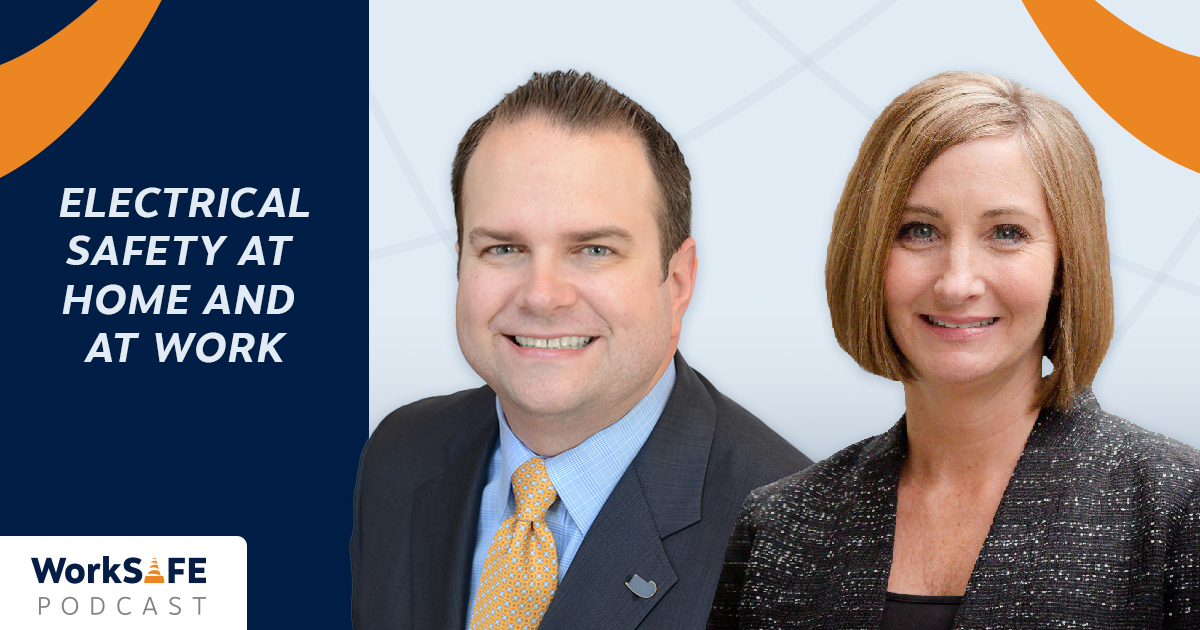For Media Inquiries
Contact Revee White, Director of Marketing and Communications at rwhite1@mem-ins.com or 573.499.4190.
Electricity is an important part of life today. It’s all around us. Our homes are full of smart tech and appliances. Businesses rely on it to power machines and devices. It even powers the phones in our pockets! Many people learn the safety basics of electricity growing up. The rules seem simple. Electricity and water don’t mix. Don’t touch live wires. Avoid putting things in outlets that don’t belong. Basic measures like these are easy to follow. They help teach people how to use common electrical appliances. However, that doesn’t mean they always use them like they should.
Workplaces in all industries rely on electricity. It keeps machines and phones going, computers and tools ready. Electricity powers the things used on the job. As a result, people can get creative – and unsafe – when trying to use it.
On this episode of the WorkSAFE Podcast, we’re joined by Brett Brenner. He is the president of the Electrical Safety Foundation International. He has over 15 years of experience in electrical safety.

First, we’ll share how electricity puts employees at risk. Then, we’ll talk about three ways to reduce risk. Finally, we’ll discuss tips for employees working remotely.
Listen to this episode on the WorkSAFE Podcast, or read the show notes below.
Hidden dangers of electricity
Electricity is everywhere. For example, Brenner points to airports. Lights are always shining. Screens show flight times and numbers. They are also full of outlets for travelers. Anyone looking to charge a phone or computer can; they just need to find a free spot. We often don’t think about electricity until we don’t have it – or until there’s an incident. And by then, someone has gotten hurt.
“Electricity is unique in the fact you can’t see it, smell it, taste it, or anything else,” Brenner explained. It isn’t like a spill on a tile floor, or a fire making smoke and heat. Electricity is a danger hidden from sight. There are roughly 200 deaths every year from it. Further, injuries from shock can have serious, long-lasting effects. They include burns and damage to the nervous system. Brain and heart function can also be affected. The body may also lock up when shocked. As a result, it can be hard to predict or control the level of injury. “When it’s there, you’re going to know it’s there,” Brenner added.
Bad behavior puts employees at risk
Skipping safety steps can feel easy in the moment. It might look like adding a plug to an overloaded power strip. Or trying to make a quick fix to a running machine. Brenner has seen electrical rooms turn into storage closets. Employees may stick mops and buckets there in a hurry. “People don’t respect the danger of electricity,” Brenner noted. Employees may also skip steps like:
- Protective gear. Insulating gloves and sleeves help reduce the impact of a shock. Without them, employees are exposed.
- Lockout and tagout. Equipment and machines should be turned off before starting repairs. Without this important safety control, employees are at risk of shock or even amputation.
- Energy testing. Wires and devices should be tested for electricity before working on them. No testing can mean an injury before a job even begins.
But sometimes, employees don’t even know what they are up against. Over 60% of the time, workers injured by electricity haven’t been trained on potential risks. Employees need to learn the risks. They need to respect the level of danger. Most importantly, they need to learn how to use it appropriately. Even a little exposure to safety information can save a life.

Electrical safety: 3 ways to reduce your risk
Hire the right people
Many businesses want to save money. As a result, they hire a “jack of all trades”. This person may have many roles. Does a lightbulb need fixing? Is an outlet not working? This employee is the one to step in. However, there could be hidden risks. Is this person qualified to do electrical work?
For Brenner, it’s important to hire someone who can work safely. Look at the employee’s job responsibilities. What tasks are okay for them to work on? Which ones are out of their field of expertise? All savings are lost if an incident occurs. Hire only those who are qualified to do electrical work. Don’t assume that someone is qualified. It can put you at legal risk. Further, it may makes them a potential safety hazard. If a full-time employee isn’t in the budget, then hire a professional when you need one.
Do a safety audit
Some businesses are new to their communities. Others have been around for a while. Both should complete an electrical safety audit. “Look at things holistically,” Brenner recommended. “Energy can be dangerous.” He points employers to the National Fire Safety Association standards. They are a good place to start.
Walk through your business. During this time, make some observations. Are employees wearing the right gear? Does site equipment have clear labels? Do employees know the safety rules? Write down any areas of improvement. Then, start there.
Hold safety training
A safe workplace is important. Likewise, a safe workforce is also. Employees need regular safety training. Employers should also think about anyone coming into the workplace. For example, many businesses have night crews. Others welcome cleaning or maintenance crews after hours. “Humans unfortunately are really good about working around safety protocols,” Brenner added.
First, hold safety training for your employees. Train them on electrical safety. Then, put safety rules in place. Finally, schedule safety meetings to follow up on this information. Tell them about meetings dates and times in advance. This way, workers on different shifts can make plans to attend.
If you have visitors coming to your business, then prepare for them. Clearly mark energized areas or equipment. Further, secure any areas that would be unsafe to access. Don’t allow supplies or tools to be stored areas like this.
Electrical safety: Sparking good habits at home
COVID-19 means many employees are working remotely. The pandemic caused people to be more careful. But increasing caution fatigue means more people may be letting safety slide. It’s simple to train employees to be safe on the job. However, they don’t always follow those rules at home. Cover these topics with remote employees:
- Home improvement. Call 811 before doing any yard work. They can alert to any buried utility lines. Further, be careful of overhead powerlines. A quick touch with a ladder can have serious consequences. In addition, downed power lines are a danger. They don’t spark or move. Don’t touch or approach someone laying near one. First, call for help.
- Surge protection. Smart tech is popular. It is also sensitive. Brenner shared that 80% of power surges affect the whole home. Surge protection can help protect smart tech. It can also help extend the life of other appliances, like stoves and fridges.
- Work area. Dining tables and basements are the new home offices. Keep desks clear of liquids like coffee and tea. Dispose of trash often. Every home should have a fire extinguisher and exit plan.

Electrical safety: Quick wins
Electrical safety is vital in every workplace. Not sure where to start? Brenner shared a few quick wins employers can focus on today:
- Test backup power. Many businesses buy generators. They provide power in case of an outage. But they also can produce noise, vibration, and carbon monoxide. Learn to use generators ahead of an emergency.
- Limit extension cord use. Extension cords can help deliver power where you need it. However, they aren’t meant for long term use. Further, they can wear out over time and become a fire risk. Check work areas for extension cords. Start identifying permanent solutions.
- Review job descriptions. Take a look at the roles in your businesses. Does anyone work with electrical equipment? Make sure they are qualified. If not, then look for someone with a skillset and professional training.
Electricity helps businesses in so many ways. When used correctly, it powers productivity. But when used incorrectly, it can result in serious risk. Make electrical safety a priority for your business today.
For free safety posters, sample policies, and safety toolkits, visit our Resource Library. Then, explore tips for professionals new to safety roles in this WorkSAFE Podcast episode.